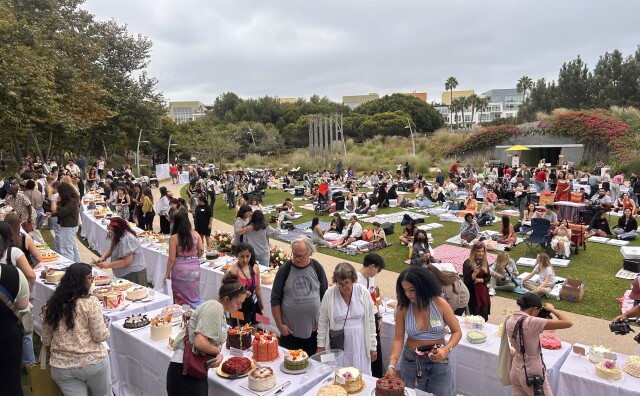Congress has cut federal funding for public media — a $3.4 million loss for LAist. We count on readers like you to protect our nonprofit newsroom. Become a monthly member and sustain local journalism.
This archival content was written, edited, and published prior to LAist's acquisition by its current owner, Southern California Public Radio ("SCPR"). Content, such as language choice and subject matter, in archival articles therefore may not align with SCPR's current editorial standards. To learn more about those standards and why we make this distinction, please click here.
Merce Cunningham--Where Today's Dance Began

Photo of a young Merce Cunningham courtesy of Flickr
Pioneering dance innovator Merce Cunningham died of natural causes this past Sunday at his home in New York City. At the age of ninety and having already influenced thousands of dancers and choreographers across the globe, the impact of his artistry will continue to be felt in his absence.
The recipient of countless awards and international honors, the always forward-thinking creator only recently announced plans for his legacy to remain true to its origins. His iconoclastic dance technique, related to ballet but tilted, extended and re-imagined beyond ballet’s range, has been documented, codified and disseminated in the teachings of many of his previous company members and the many who trained at his studio in the West Village.
His approach to dance making, however, influenced by Eastern philosophies, chance and a broad vision of the landscape for performance, will remain specifically his, in spite of the many derivative exponents of the art form. Cunningham, aligned with his professional and personal partner, composer John Cage, re-scripted the process for making work. They produced plotless dances, with all of the accompanying elements—music/sound, costume and décor—being designed and developed independently of the dance. It was at the first performance that all these contributions came together, making for an often surprising new relationship of each art form to the other.
Cunningham was born in Centralia, Washington in 1919 and began his training there as a tap dancer. He soon moved to New York, where he made his way into the company of another pioneer, the indefatigable Martha Graham. And, whereas Graham opted for narrative and emotion in her choreography, Cunningham explored the unknown. His first dances—solos for himself with sound scores by Cage—were not well received, but by 1953, he formed his own company. They made their big international splash in 1964 and the rest has truly been history!
His early collaborators included people like Andy Warhol, Jasper Johns and Robert Rauschenberg and Cunningham was one of the first to experiment with dance on video and dance on the computer. In the ‘90s he blazed a trail of new creative energy as he used newly created software to re-design the human body and its potentials. A few years ago, he brought his company to southern California and each audience member was loaned an audio ipod with a personalized shuffle so that each viewer heard a different score to accompany the dancing on the stage. His company members were always the most highly refined athletes and artists, able to do nearly impossible feats and demand our focused attention in performance.
Cunningham authored books about his work—both dancing and drawing—and his foundation maintains a comprehensive archive of his life work and experience.
His zest for innovation will be missed, but he will never be forgotten!
Check out these youtube vids (lots more):
Recent interview and video portrait
Early experiment with video and dance:
As Editor-in-Chief of our newsroom, I’m extremely proud of the work our top-notch journalists are doing here at LAist. We’re doing more hard-hitting watchdog journalism than ever before — powerful reporting on the economy, elections, climate and the homelessness crisis that is making a difference in your lives. At the same time, it’s never been more difficult to maintain a paywall-free, independent news source that informs, inspires, and engages everyone.
Simply put, we cannot do this essential work without your help. Federal funding for public media has been clawed back by Congress and that means LAist has lost $3.4 million in federal funding over the next two years. So we’re asking for your help. LAist has been there for you and we’re asking you to be here for us.
We rely on donations from readers like you to stay independent, which keeps our nonprofit newsroom strong and accountable to you.
No matter where you stand on the political spectrum, press freedom is at the core of keeping our nation free and fair. And as the landscape of free press changes, LAist will remain a voice you know and trust, but the amount of reader support we receive will help determine how strong of a newsroom we are going forward to cover the important news from our community.
Please take action today to support your trusted source for local news with a donation that makes sense for your budget.
Thank you for your generous support and believing in independent news.

-
Administrators say the bargaining units should be dismissed, or that they have no standing. One campus is going after the federal agency in charge of union activity.
-
The landslide is not connected to the greater Portuguese Bend landslide, city officials said.
-
Nom. Nom. Nom. The event destroyed the internet when it was first announced — and sold out in minutes.
-
The critical findings are part of long-awaited after-action report was released Thursday. It contains recommendations for increasing emergency staffing and updating old systems.
-
Diving has changed, mountain biking has been added. Here's where to watch the Olympics in person in 2028.
-
'A Great Day in the Stoke' is a free, daylong event in Orange County billed as 'the largest gathering of Black surfers in history.' The fourth annual festival is set for Saturday in Huntington Beach.







